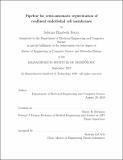| dc.contributor.advisor | Elazer R. Edelman. | en_US |
| dc.contributor.author | Ibarra, Sabrina Elizabeth. | en_US |
| dc.contributor.other | Massachusetts Institute of Technology. Department of Electrical Engineering and Computer Science. | en_US |
| dc.date.accessioned | 2020-03-24T15:36:21Z | |
| dc.date.available | 2020-03-24T15:36:21Z | |
| dc.date.copyright | 2019 | en_US |
| dc.date.issued | 2019 | en_US |
| dc.identifier.uri | https://hdl.handle.net/1721.1/124249 | |
| dc.description | This electronic version was submitted by the student author. The certified thesis is available in the Institute Archives and Special Collections. | en_US |
| dc.description | Thesis: M. Eng., Massachusetts Institute of Technology, Department of Electrical Engineering and Computer Science, 2019 | en_US |
| dc.description | Cataloged from student-submitted PDF version of thesis. | en_US |
| dc.description | Includes bibliographical references (pages 54-56). | en_US |
| dc.description.abstract | Changes in cell morphology are important indicators of underlying biological changes. As endothelial cells (EC) heterogeneously respond to stimuli, we seek to quantify EC morphologic heterogeneity and relate it to transcriptome phenotypes; however, existing semi-automatic methods for quantifying cell shape require adjusting complex, non-linear hyperparameters by trial and error, making it difficult to attain the level of accuracy required to assess individual cell parameters. Manual segmentation, on the other hand, is not feasible for assessing heterogeneity because it requires segmentation of each individual cell. In this project, we tested two approaches to semi-automatic cell segmentation to improve both accuracy and speed. First, we built a tool that interfaces with Cell- Profiler, the current state-of-the-art cell segmentation software. | en_US |
| dc.description.abstract | Our tool identifies the optimal set of CellProfiler hyperparameters by sweeping through and comparing the accuracy to a manually segmented gold standard of 1,333 cells. We used these data to confirm high accuracy with a gold standard subset size of as few as 30 manually segmented cells, achieving an accuracy guarantee within 3.08% of the maximum attained 97.30% with our chosen model of error. This Cell-Profiler-based approach provides a semi-automatic alternative more accurate than the previous method of trial-and-error adjustment of hyperparameters. For our second approach, we explored a deep learning algorithm that uses one round of user-interactive delineation in regions of model uncertainty. While this approach proved more difficult given the limited availability of data and the difficulty of propagating the user-provided knowledge--only achieving a marginal 1% increase with ten interventions-- | en_US |
| dc.description.abstract | we succeed in introducing a novel method of boosting cell segmentation accuracy and pave the way for future improvements. Ultimately, this project delivers a tool that can revolutionize the way scientists currently use CellProfiler and a proof-of-concept way to increase the ability of an existing deep learning algorithm to generalize. The increase in time and accuracy gained by these methods removes previous barriers to the quantification of EC morphologic and biologic heterogeneity. | en_US |
| dc.description.statementofresponsibility | by Sabrina Elizabeth Ibarra. | en_US |
| dc.format.extent | 56 pages | en_US |
| dc.language.iso | eng | en_US |
| dc.publisher | Massachusetts Institute of Technology | en_US |
| dc.rights | MIT theses are protected by copyright. They may be viewed, downloaded, or printed from this source but further reproduction or distribution in any format is prohibited without written permission. | en_US |
| dc.rights.uri | http://dspace.mit.edu/handle/1721.1/7582 | en_US |
| dc.subject | Electrical Engineering and Computer Science. | en_US |
| dc.title | Pipeline for semi-automatic segmentation of confluent endothelial cell membranes | en_US |
| dc.type | Thesis | en_US |
| dc.description.degree | M. Eng. | en_US |
| dc.contributor.department | Massachusetts Institute of Technology. Department of Electrical Engineering and Computer Science | en_US |
| dc.identifier.oclc | 1145120409 | en_US |
| dc.description.collection | M.Eng. Massachusetts Institute of Technology, Department of Electrical Engineering and Computer Science | en_US |
| dspace.imported | 2020-03-24T15:36:21Z | en_US |
| mit.thesis.degree | Master | en_US |
| mit.thesis.department | EECS | en_US |
